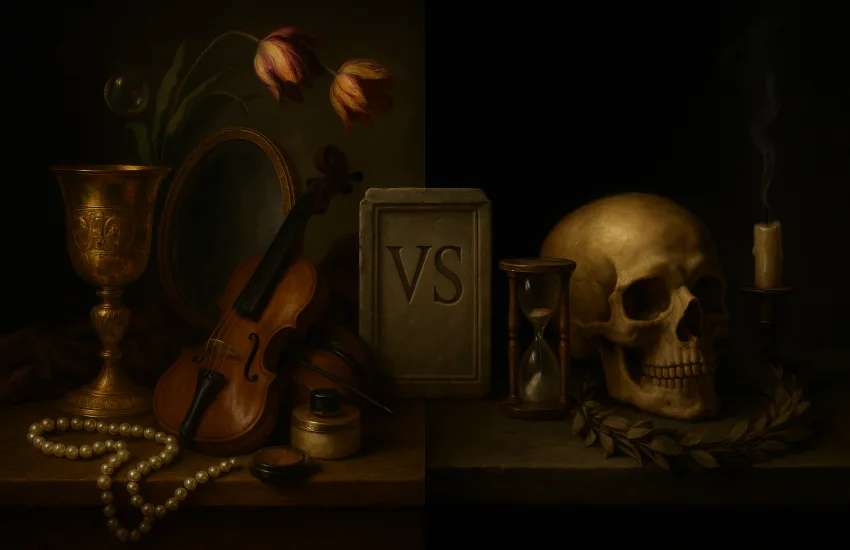Chiaroscuro vs Tenebrism
Chiaroscuro vs tenebrism compares two related but distinct lighting approaches in painting. One builds form with gentle value transitions, while the other stages a dramatic spotlight against deep darkness.
Chiaroscuro vs Tenebrism: Definitions
This section clarifies what each term means and how artists use them in practice. Understanding the intent behind the light helps you read a scene—and create one—more effectively.
What is Chiaroscuro?
Chiaroscuro models volume through gradual shifts from light to shadow. The aim is realism, roundness, and a calm sense of depth achieved with mid-tones.
What is Tenebrism?
Tenebrism heightens drama by placing figures in a largely dark setting and striking them with a focused beam of light. Here shadow dominates the stage, and light acts like a theatrical cue.
Chiaroscuro vs Tenebrism: Key Differences
While both rely on contrast, they differ in how contrast is distributed and why it is used. Spot the background first, then the speed of the falloff from light to dark.
Lighting & Background
Chiaroscuro spreads light broadly and preserves a spectrum of mid-values. Tenebrism suppresses those mid-values, pushing the background toward near-black.
Purpose & Mood
Chiaroscuro serves volume, observation, and serenity. Tenebrism serves emphasis, suspense, and narrative punch.
Composition & Edges
Chiaroscuro favors soft edges and layered planes. Tenebrism uses hard accents, high contrast, and a directional beam that commands attention.
Historical Context & Artists
Both ideas appear across centuries, but their peaks differ. Knowing the period helps you anticipate which approach you are likely seeing.
Renaissance to Mannerism
Chiaroscuro supports sculptural form and measured space. Painters chiseled bodies with light, deepening realism and anatomical presence.
Baroque Masters
Tenebrism surges in the Baroque with theatrical storytelling. Light singles out protagonists, turning scenes into charged moments of revelation.
How to Spot Chiaroscuro vs Tenebrism
Read the background value and the light’s spread. Rich mid-tones and gentle falloff signal chiaroscuro; a small, intense pool of light against darkness signals tenebrism.
- Chiaroscuro: silky transitions on faces, drapery, and spheres.
- Tenebrism: a “stage light” that makes forms suddenly emerge.
Using Them in Your Own Work
Choose based on message: clarity and solidity suggest chiaroscuro; urgency and drama suggest tenebrism. You can combine them—model with chiaroscuro, then hit the focal point with a tenebrist accent.
Simple Lighting Setup
For chiaroscuro, place a broad diffused light at roughly 45° and lift shadows with a reflector. For tenebrism, use a small, close light source and keep the background as dark and non-reflective as possible.
Color & Surface Choices
Chiaroscuro benefits from warm-cool shifts that enrich skin and fabric. Tenebrism loves glossy accents on a dark ground; a single highlight can carry the plot.
Quick FAQ
These common questions help settle terminology when analyzing or teaching. Keep the function—modeling vs drama—in mind as the core divider.
Is tenebrism just “strong chiaroscuro”?
No. Tenebrism is a compositional strategy that makes darkness the default and light the event. Chiaroscuro remains more balanced and primarily modeling-oriented.
Can one painting use both?
Yes. Many works build bodies with chiaroscuro yet reserve a tenebrist spotlight for the narrative climax. The blend delivers both solidity and impact.


